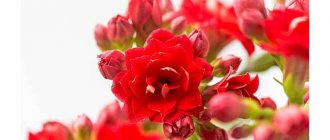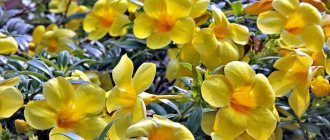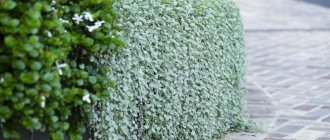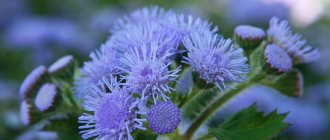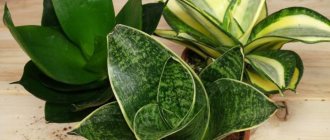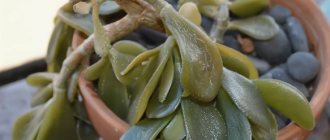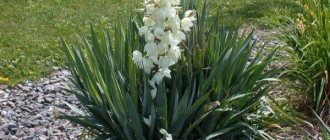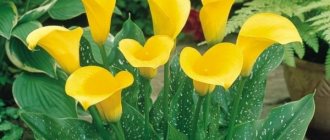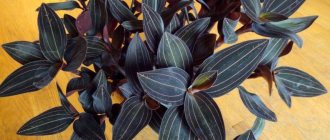Photo Nematanthus is a decorative shrub from the Gesneriaceae family. The shoots of a young plant point upward; in adulthood they become heavy and droop down. Under natural conditions, plants are distributed in the tropical zones of Colombia, Chile, Uruguay, and the homeland of Nematanthus is Brazil. The perennial plant develops quickly, the length of drooping shoots can reach at least 0.3 m.
It is not difficult to grow the nematanthus subshrub at home. It blooms all summer, forming many small tubular flowers that look like golden fish. Previously, the genus Hypocyrta and the genus Nematanthus were considered separate genera of the same family. According to the modern classification, they are combined, but sometimes Nematanthus continues to be called hypocyrta, although the name is considered outdated.
Be sure to pay attention to such wonderful plants as Achimenes and Columnea.
| The growth rate is high. |
| Blooms all summer, producing many small tubular flowers that look like goldfish |
| The plant is easy to grow. |
| It is a perennial plant. |
Botanical description of the hypocyrt plant
The genus Nematanthus includes 6 species. Among them are epiphytic and semi-epiphytic vines, as well as shrubs and subshrubs.
| Genus | Hypocyrta |
| Family | Gesneriaceae |
| Motherland | South America |
| Escape type | Straight, creeping |
| Inflorescence | Axillary |
| Petal color | Yellow, orange, coral |
| Leaf structure and color | Succulent, elliptical, obovate, dark green |
| Flowering period | March - September |
| Fetus | Achene |
| Reproduction | Seeds, cuttings |
Based on the botanical description of the hypocyrt, the stems of these plants are thin, flexible, in young specimens they are straight, in older specimens they are creeping, because over time they become very long and bend under their own weight.
The leaves are arranged oppositely along the entire length of the stem. The leaf blades are dense, fleshy, oval or elliptical, smooth, shiny. The leaves are dark green on top, and violet, red, purple on the reverse side. Aerial roots and inflorescences form in the leaf axils.
The leaves of some species have pubescence, and it is denser; if the bush grows in partial shade and shade, in the sun the leaf plates do not acquire hair.
The peduncles of representatives of this genus can be long or short, depending on the species. The flowers are tubular, 4–5 cm long. The corolla is rich yellow, red, pink, purple or orange. The petals are fused inside, the edges at the base are bent. Due to these features, the flower has a specific shape. This plant begins to bloom in March-April, flowering lasts until September, sometimes longer. In bright light it can bloom in winter.
At home, nematanthus is grown in hanging pots and flowerpots as an hanging plant. Both young and mature overgrown bushes look very impressive, so this crop is considered one of the most popular among connoisseurs of indoor plants.
How impressive and extraordinary the indoor hypocyrtus flower (nematanthus) looks can be seen in the photo below, where you can see the unusual buds and beautiful foliage:
About the name of the plant
Nematanthus, as noted above, is a genus of the Gesneriaceae family. The latter includes 28 plant species. The flower owes its name to the German doctor of medicine and professor of botany Heinrich Adolf von Schröder, who created the word “nematanthus,” meaning “flower on a thin peduncle.” And it is called “Goldfish” due to the similarity of the shape and shade of the plant’s flower.
Today, the genus Nematanthus and the genus Hypocyrtus are combined, so it can rightfully be called by a second name. The plant has been known in cultivation since 1846.
Description
The leaves of the indoor flower "Goldfish" are slightly pubescent, opposite, elliptical, shiny, small, dark green. Young stems are usually erect, but begin to bend and droop from the weight of the leaves.
The axillary inflorescences of nematanthus have short peduncles. The tubular-shaped flowers are waxy and have a length of about 5 cm. The corolla has a red, pink, dark purple or orange color. The stems are creeping, covered with fleshy, glossy, small leaves. Nematanthus blooms abundantly and for a long time - from spring to autumn. The plant is cultivated as a hanging plant - in hanging baskets or flowerpots.
Very unusual flowers in color and shape are similar to small bright aquarium fish. Thanks to such flowering, nemananthus is usually called the “Goldfish” flower (photo presented in the article).
Watering and air humidity
The “Goldfish” flower is also unpretentious in terms of watering. Caring for him in this regard is easy. During active growth, watering should be plentiful. By winter it should be gradually reduced, bringing it to moderate. The plant should be watered as soon as the surface of the substrate dries completely. For this purpose, it is advisable to use only settled and soft water, at room temperature.
For this plant, the humidity level must correspond to the temperature in the room: the higher it is, the higher the air humidity should be. For example, at temperatures around 21 ° C, air humidity should be maintained within 50%, and at temperatures up to 27 ° C, humidity should be approximately 60%. It is advisable to spray from a spray bottle daily.
Variety of species
In the Nematanthus genus, botanists count 28 species, approximately 7–8 of them grow in the flower beds of amateur plant growers around the world.
- Nematanthus Gregarius is perhaps the most spectacular and is therefore most often cultivated by flower lovers. It is he who is known by his second name - “Goldfish”. This species of Nematanthus has thick, dark green leaves and bright red-orange flowers that actually resemble aquarium fish. There are several varieties of Gregarius, the most famous being the Australian subspecies. It looks best in wall or hanging pots: with this type of cultivation, it does not need to cut off its shoots, let its vines flow beautifully. This is a spectacle for true exotic lovers.
- The Wetstein species is also very common. It produces many liana-like shoots up to 90 cm long. The leaves of this plant are small, oval in shape. Their surface is glossy waxy, the color is rich dark green. The flowers are tubular, yellow, orange-red, slightly swollen, up to 2.5 cm long. They look magical against the background of dark green foliage. Like other members of the genus, Nematanthus Wetstein blooms continuously from spring to mid-autumn.
- Fritsch's view. Less common than the previous two, but still well known. Nematanthus Fritsch is a relatively large, beautiful species with fairly large leaves that have a slight edge on the underside. Nematanthus Fritsch forms bushes up to 60 cm tall. Its flowers are gracefully curved, bright pink, and shaped like a funnel.
- Nematanthus finely bristle is a small bush 20–25 cm high, producing straight ascending shoots that are quite branched. The leaves of this type of nematanthus are oval, shiny, small, single or collected in threes. The flowers are tubular with a spherical swelling, with a corolla that has a slight bend. The color of the buds is bright yellow-orange, classic for the Nematanthus genus.
- Nematanthus locustus belongs to the type of climbing subshrubs. Its leaves are light green and large, reaching a length of 7–10 cm. The pedicels are equally long, with single red flowers, strongly swollen on the tube.
- Prirechny view. This is also a very graceful climbing plant. The leaves of Nematanthus riverine are large, ellipsoid, about 10 cm long, their reverse side is purple. The flowers are lemon yellow, up to 5 cm long. The flower's throat, unlike most nematanthus, is unfolded, the tube is pubescent on the outside.
- Nematanthus Tropicana stands out from other nematanthus with large, pitcher-shaped flowers. In the lower part they are swollen, their color is yellow-orange, bright. Stripes of red-brown and golden-burgundy color stand out noticeably on the buds. The bracts are red-orange. The inflorescences are incredibly beautiful. The underside of the dark green, dense, glossy Tropicana leaves has a reddish tint. The shape of the leaves is oval, pointed. The shoots are erect, but over time they droop and branch. The Nematanthus Tropicana species is very popular among plant growers because it blooms profusely and effectively for a long time.
- The unique species of Nematanthus Santa Teresa is considered to be less common, but it cannot be confused with others due to its striking large flowers. They reach 5 cm in length, are white or cream in color and are abundantly dotted with yellow dots and spots. The shape is tubular, the pubescence is weak. The flowers emit a delightful aroma reminiscent of zest and olive oil. The throats of Nematanthus Santa Teresa flowers, unlike other species, are wide open to attract insects for the purpose of pollination. Large (up to 7 cm) dark green elongated leaves of Nematanthus Santa Teresa have reddish veins and pubescence on the underside. The shoots can reach 70 cm, but during the growth process they droop and branch.
- The variegated (variegated) forms of nematanthus are worth special mention. Such forms of plants arise due to genetic mutations: some leaf cells do not produce chlorophyll, so the leaves acquire light green or white spots. Variegated nematanthus are extremely beautiful.
What types of nematanthus are grown at home?
Several varieties of hypocyrta are grown at home. Nematanthus, namely its character depends on the species. There are only 6 copies that will perfectly complement the flower collection.
Nematanthus tropicana
Hypocyrta with oval leaves. The plate has a sharp tip and a smooth, leathery surface. The structure of the flower is similar to a slightly tilted jug. The corolla is yellow, orange or dirty brown. There are random red or burgundy spots on the tube, as well as a golden stripe.
Gregarius - hypocyrta "goldfish"
The leaves are glossy and smooth. During the flowering period, swollen buds of yellow or red color are formed. If you look at the photo, it will immediately become clear why this variety of nematanthus is compared to goldfish.
Naked hypocyrta
When young, the plant has straight stems. They grow vertically. Mature crops can hardly be called hanging crops, but they can be grown in hanging pots. Leaves are medium sized (up to 4 cm). They are glossy, fleshy, covered with a leathery plate.
Coinfolia Nematanthus
This particular species is a money plant. Hypocyrta has small green leaves, shaped like coins with a crenate edge. Red flowers with a yellow edge appear in spring. The species is grown as an ampelous plant. An important feature of the nematanthus is that it sheds its leaves in the fall as soon as the last buds fade.
The most popular hypocyrt variety is Albus . It is very rare, has green foliage and incredibly beautiful white buds with brown speckles.
Riverine nematanthus
A beautiful variety with stems that develop like a vine. This is a climbing plant, capable of clinging to ledges with its shoots. The leaf blades are ellipsoidal, up to 10 cm long. The reverse side of the blades are painted red or burgundy. During flowering, yellow buds are formed on long flowering stems.
Nematanthus anklet
Epiphytic shrub with an aerial root system. The leaf blades are rounded and light green in color. The leaf is long, up to 10 cm and up to 4 cm wide. Hypocyrta blooms with red single buds. It has long peduncles - up to 10-12 cm.
Photo
Below are photos in which you can see how to care for a flower at home and outdoors.
Caring for nematanthus at home
Illumination
In order for the nematanthus to grow and develop within normal limits, it will need bright, diffused lighting, and the daylight hours should be from 12 to 14 hours. When choosing a suitable place for such a flower, preference should be given to window sills located in the western or eastern part of the room. This flower can also be grown on a north-facing window, but it should be taken into account that in the cold season the flower may not have enough light, which can have an extremely negative effect on flowering. If the flower is placed on a southern windowsill, then in summer it will require obligatory shading during the midday hours from the scorching direct rays of the sun, otherwise burns may appear on the surface of the leaves. In winter, the plant needs a lot of bright light just as much as in summer. If sunlight is not enough for the nematanthus, then it can be supplemented by installing, for example, a phytolamp. If the flower is very large, then placing it under a fluorescent lamp will be quite problematic.
Temperature
Throughout the growing season, the flower should be kept warm. It grows best at this time at an air temperature of 19–24 degrees. In winter, the nematanthus has a dormant period, during which the flower should be in a cooler place (from 14 to 16 degrees). The plant tolerates short-term temperature drops normally. However, if the room in which it is located is colder than 13 degrees for a long time, then this will have an extremely negative impact on its decorative effect. If the air temperature in the room drops to 7 degrees, then the foliage will turn brown and fly off. If, on the contrary, it is very hot (27 degrees or more), then this will also negatively affect the development of the flower. The flower responds well to a decrease in air temperature at night by 5–10 degrees.
Watering
In the warm season, during the period of active growth, the nematanthus is watered regularly and abundantly, immediately after the top layer of the soil mixture in the container has dried. With the onset of the dormant period in the cold season, the abundance and frequency of watering must be reduced, especially if the flower is in a cool room. You only need to moisten the soil mixture in a flower pot with well-settled, soft water, the temperature of which should be close to room temperature. If a species is grown with fairly large leaf blades that absorb a larger volume of water, then it is recommended to resort to differentiated watering, and it is necessary to take into account the size of the bush, the size of the foliage and the composition of the soil mixture.
You can understand that the plant does not have enough water by the following signs: small leaf plates fly around, and large leaf plates curl. If the earthen lump is very dry in the pot, then you will need to immerse the bush along with the container in a basin filled with water. After the dried substrate is saturated with water, the pot with nematanthus is pulled out of the basin. If there is a void between the lump of earth and the pot, then it needs to be filled with fresh substrate.
Air humidity
The optimal air humidity level for indoor nematanthus is about 50%. It should be taken into account that the warmer the room, the higher the air humidity level should be and vice versa. If the air temperature in the room is no more than 21 degrees, then the air humidity should be about 50%. At air temperatures up to 27 degrees, the air humidity level must be increased to 60%.
In the spring-summer period, the flower responds well to daily moistening from a sprayer; for this it is recommended to use warm and soft water. During cool wintering, the bush cannot be moistened, but if there is a need to increase the level of air humidity, then take a tray filled with wet pebbles or expanded clay, and place a pot with nematanthus on it.
Top dressing
During the growing season, the plant is fed regularly once every 15 days, using complex mineral fertilizer. In autumn, the flower is fed less often, and in winter, fertilizers are not added to the soil mixture at all.
Flowering and pruning
Nematanthus flowering begins in spring and ends in autumn. However, if the flower receives enough light in winter, it may begin to bloom. This plant differs from many others grown indoors in that its flowers form only on young shoots. In this regard, for lush and spectacular flowering, it is necessary to systematically carry out rejuvenating pruning of the bush. As a rule, the bush is pruned immediately after it has finished flowering. If in winter the flower is not moved to a cool place, then its shoots become very elongated. In this case, another pruning will be required in early spring in order to shorten the stems that are too long.
If the bush is already very old, it may lose its decorative effect. But don't rush to throw it away. Cut off its most powerful shoots and root them like regular cuttings. Thanks to this, instead of one old one, you will have several young and beautiful bushes.
Stimulating nematanthus flowering with formative pruning
Every year, before the dormant period in autumn (October), the nematanthus is pruned to stimulate flowering for the next active period. If the plant overwinters in a warm room, the formation process is postponed until spring. This will heal and rejuvenate the goldfish.
Remove diseased, thin stems. Healthy young shoots are shortened by 1/3, aged ones by half.
Transfer
Nematanthus is replanted in the spring, but only when necessary. When choosing a new pot for replanting, you should take into account that it should be only slightly larger than the old one, since in a container that is too spacious, the bush may not bloom for a long time. So, the new container should be 10–20 mm larger in diameter than the old one.
It is imperative to make a good drainage layer at the bottom of the pot so that there is no stagnation of liquid in the substrate, which must be loose. The soil mixture should be light, loose, well-permeable to water and air, neutral or slightly acidic with a pH of 5.5–6. The approximate composition of a soil mixture suitable for growing nematanthus can be as follows: leaf soil, sand, peat and humus, taken in a ratio of 2:1:1:1. It is recommended to add small pieces of charcoal and sphagnum moss chopped with scissors to the finished substrate.
How and when to replant nematanthus
Nematanthus is a slow growing flower. Young ones are replanted only after 2-3 years, and adults - when the roots come out of the drainage holes. They do this in the spring.
Take a small container, about 2 cm wider than the previous one.
The following substrate options are used:
- soil for violets:
- leaf, peat, sand (1:1:1) with the addition of crushed bark and moss;
- leaf, humus, peat, sand (2:1:1:1), charcoal crumbs.
The container and soil are disinfected (boiled in a water bath or doused with boiling water). Drainage is important (expanded clay, pebbles, vermiculite).
Transplantation is carried out using the transshipment method, taking care not to damage the delicate roots. Afterwards, water the plant with warm water, spray it, and place it in the chosen place.
Choosing a landing site and lighting
The optimal place for the constant growth of any type of nematanthus is the window on the east or west side of the house. The plant can also grow near a north window, but in this case it will not have enough light in autumn and winter, which can negatively affect flowering. Also, when placing a flower on the south side in the summer, shading should be arranged, since direct sunlight contributes to the appearance of burns on the plant.
In general, the duration of daylight hours should be approximately 12-14 hours a day. In winter, it is necessary to use artificial lighting.
Reproduction of nematanthus, obtaining new fish flowers
Nematanthus is propagated by seeds and cuttings.
Seminal
This method is labor-intensive and time-consuming:
- Prepare a tray and a container with drainage holes, add peat and sand, and moisten it.
- Ripe seed boxes are opened, the latter are poured onto paper, then distributed over the substrate and covered with a transparent material (glass, film).
- Water into a tray and ventilate regularly.
- After the sprouts appear, the shelter is removed.
- After 2 weeks they are picked.
- 3-4 seedlings are placed in one pot. Young nematanthus bloom the next year.
Cuttings
After pruning, healthy approximately 10 cm (4-5 nodes) cuttings are rooted in peat, moss, and water.
- The lower sheets are removed, the sections are treated with Zircon or Epin, immersing the planting material 1 cm in the solution.
- The cutting node on which roots are formed is deepened into a rooting container and covered with a glass jar.
- They create +22…+25 °C and light.
- After 2-3 weeks, they are planted in small pots of about 10 cm, 3-4 pieces each.
Errors in caring for nematanthus, pests and diseases
When grown in the wrong conditions, nematanthus can get sick and be attacked by insects.
| Symptoms External manifestations on leaves | Cause | Corrective measures |
| Dropping flowers. Leaf fall. | Winter period: waterlogged soil, low temperature. Growth and flowering period: lack of moisture in the soil and air. | Reduce watering. Move to a warmer place. If the damage is severe, the flower is transplanted into new soil. |
| Yellowing, curling. The appearance of brown spots. | Excessive direct sunlight. Burns. | Place it away from the window. Shade. Spray early in the morning or evening. |
| Withering. | Overfeeding with fertilizers. | Follow the feeding rules. |
| Lack of flowering. | Lack of lighting, nutrition, dry air, cold. There was no trimming. | Create the right conditions of detention. |
| Drying and yellowing. | Heat and dryness. | Increase humidity (place in a tray with wet pebbles, place a container of water and a humidifier nearby). |
| Darkening of flowers, their falling | Drops of water getting on the buds. | Use only a fine spray, do not get on the flowers. |
| The appearance of depressions. | Incorrect watering. | Maintain a watering schedule. |
| Whitish wet coating. Death of leaves. | Mealybug. | Remove insects with an alcohol wipe. |
| Covered with light yellow spots, the formation of cobwebs. | Spider mite. | Spray with Actellik, Fitoverm. |
| Slow growth. Deformation, silver smudges. | Thrips. | |
| Insects are visible. | Aphid. | Treated with Antitlin, Biotlin |
| Mold. | Gray rot. | Remove the affected areas and change the substrate. Use Fundazol. Reduce watering and ventilate the room. |
| Withering, yellowing and death. | Root rot. | The diseased roots are removed, the plant is dried, replanted, and watered with Carbendazim. |
| White plaque. | Powdery mildew. | Spots are removed manually or diseased leaves are torn off. Treated with Fitosporin. |
Possible difficulties
Weak flowering or no flowering. The reason for this is poor lighting, lack of nutrients, too dry or cold air, and possibly lack of pruning of the plant.
There are light brown spots on the surface of the leaves. A possible reason is that the water is too cold; it should be warm (20°C) for irrigation.
The plant sheds its leaves. If this happens in the autumn-winter period, then the likely cause is too low a temperature. If in the summer, and the substrate is dry, then the plant suffers from severe drying out of the root ball.
The tips of the leaves dry out and turn yellow. The reason is too high temperature and low humidity.
When the plant is flowering, when spraying, it is necessary to avoid getting large drops of water on the flowers, as they may turn brown and fall off prematurely.
, gray rot appears .
Leaves lose color intensity. There may be several reasons: direct sunlight, too dry air, or overfeeding with fertilizers.
Difficulties in growing
Problems in cultivating nematanthus appear due to improper care.
Diseases
If there is little air movement in the room where nematanthus is grown, the plant may become infected with fungal diseases. In this situation, it is treated with fungicides.
Common diseases:
- Gray rot. The sign is a gray fluffy mold that appears on the plant. For treatment, the affected parts are removed and the moldy soil is replaced. Then they are treated with fungicides (Fundazol). In addition, you need to reduce watering, stop spraying and ventilate the room more often. As a preventive measure, you should follow the rules of hydration: do not allow high humidity in a cool place.
- Rot. It manifests itself as massive wilting of leaves, which then turn yellow and die. Treatment should begin immediately. First of all, the plant is removed from the container and the root system is examined: if it is softened and darkened, it is too late to treat the flower. If most of the roots have retained their elasticity, then you can compete for the flower. To do this, carefully remove the areas affected by rot, dry them and transplant them into a new substrate, which is watered with “Carbendazim”. Preventive measures: the plant is planted in a calcined pot and soil, ensure high-quality drainage, and prevent moisture stagnation.
- Powdery mildew. It appears as a whitish coating on the foliage and stems. When the lesion occurs in a small area, the plaque is removed manually. If the entire leaf is infected, it is removed. Additionally, the flower is treated with sulfur or Fitosporin-M. As a preventive measure, the room should be ventilated more often.
Pests
The following insects are dangerous for goldfish:
- Whitefly. Some people advise treating the plant with a vacuum cleaner - “pulling in” the parasite.
- Aphid. It can be detected by twisted buds and stems, which later dry out. For the fight, drugs based on permethrin, Antitlin, Biotlin are used.
- Thrips. As a result of their vital activity, the plant slows down in development, the flowers are deformed, and silvery streaks are noticeable on the leaves. At the first signs they are treated with Akarin, Fitoverm, Actellik.
- Spider mite. These parasites are dangerous because they suck the sap from the plant and reduce immunity. The pest is identified by the condition of the leaves: they are covered with yellow spots and cobwebs. You can save the plant by spraying it with a soap solution or special products (“Akarin”, “Fitoverm”, “Aktellik”, “Kleschevit”).
- Mealyworms. Their presence is indicated by “cotton” formations in the axils of the leaves, where these insects usually like to be located. Over time, the leaves wither and die. You can save yourself from pests by treating all parts of the plant with a swab soaked in alcohol.
Did you know? In Poland, nematanthus is called
"
humpbacked flower
"
, in Germany -
"
kiss
"
.
Hypocyrta (nematanthus) - folk superstitions
There are folk tales and ancient legends about many flowers and plants. All that is known about nematanthus is that it brings happiness and good luck to its owner. It also purifies the air and decorates the house. If it looks healthy and well-groomed, it lifts the mood of the owners, since bright and unusual nematanthus create an atmosphere of real tropics in the home. That's probably all that can be said about this indoor plant. But if you know more about Nematanthus hypocyrtus than we do, be sure to share your knowledge with us.
Sources
- https://kvetok.ru/komnatnye-rasteniya/nematantus-gipocirta-harakteristika-vidov-uslovija-vyrashhivanija
- https://FB.ru/article/438521/tsvetok-zolotaya-ryibka-opisanie-s-foto-razvedenie-posadka-vyiraschivanie-i-pravila-uhoda
- https://diz-cafe.com/rastenija/nematantus-uhod-v-domashnih-usloviyah-foto.html
- https://cvetochkino.ru/?p=1056
- https://rastenievod.com/nematantus.html
- https://MrDachnik.com/nematantus
- https://flora.dobro-est.com/nematantus-nematanthus-ili-gipotsirta-hypocyrta-opisanie-vidyi-i-uhod-za-nematantusom.html
- https://green-color.ru/2968-nematantus-posadka-vyraschivanie-i-uhod.html
[collapse]
